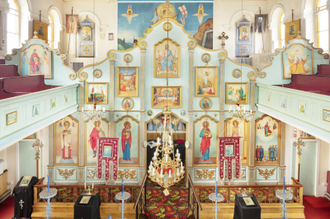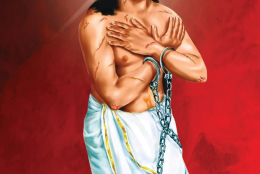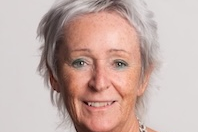Ukrainian heritage in England celebrated

St Mary Protectress, Ukrainian Autocephalic Orthodox Church, Bradford. ©Historic England
Ukrainian heritage in the north of England is being celebrated by Historic England and the Department for Culture, Media and Sport (DCMS) in the lead up to the Eurovision Song Contest.
Two Ukrainian churches in Salford and Oldham and a Ukrainian community memorial in Bradford have been granted Grade II listed status by DCMS, on Historic England's advice.
A further three churches in Manchester and Bradford and a community centre in Huddersfield - which are already listed - will have their stories updated on the National Heritage List for England (NHLE) to reflect the significance of their Ukrainian history.
For over a hundred years, people from Ukraine have called the towns and cities in the north of England home. These places help tell the story of Ukrainian life, culture and worship in the region.
Arts and Heritage Minister, Lord Parkinson of Whitley Bay, said: "With excitement growing for this weekend's Eurovision Song Contest, we want to recognise and celebrate how the people of Ukraine have helped shape our nation over many generations.
"These sites across the north of England are important for Ukrainians at home and in the UK. Granting them listed status means they can be cherished and protected for years to come. I hope this will encourage even more people to visit them and learn more about the shared history between our two great nations."
Duncan Wilson, Chief Executive of Historic England, said: "It feels right to celebrate Ukrainian heritage in the north of England as the nation gets ready to host Eurovision, on behalf of Ukraine.
"We are turning the spotlight on special places which help tell the story of Ukrainian life and traditions. Culture and customs are vital to national identity. These places were established as safe spaces, over decades, by people who wanted to keep Ukraine in their hearts and their heritage alive. They show the resilience and resourcefulness of Ukrainian communities and their dedication to protecting their language, beliefs, and way of life."
Rev Dr Taras Khomych is a Ukrainian Catholic Priest, Senior Lecturer in Theology at Liverpool Hope University and Chair of the Liverpool branch of the Association of Ukrainians of Great Britain.
Dr Taras Khomych said: "Highlighting the stories of Ukrainian communities in the north of England is a wonderful way of supporting our heritage at a time when, once again, it is under threat in Ukraine. This is welcome recognition of the role that culture and traditions play in safe-guarding our way of life."
People from Ukraine have had a powerful connection to the towns and cities in the north of England for over a century.
The first recorded Ukrainians arrived in the late 19th and early 20th century when several hundred people from western Ukraine settled in Manchester.
Following the Second World War, around 35,000 Ukrainians came to the UK as part of the European Volunteer Workers scheme. This was set up to address labour shortages by providing jobs in industry and agriculture to 'displaced' people.
Many found work in the cotton mills of Manchester and woollen industry in West Yorkshire.
More Ukrainians migrated to England following the collapse of the Soviet Union and, most recently, to escape the Russian invasion of Ukraine in 2022.
As Ukrainian communities have developed, they have often shared or adapted existing buildings to create spaces for worship, education and cultural celebrations to keep their heritage alive.
Former Victorian Anglican and Methodist buildings have been converted into Ukrainian Catholic and Ukrainian Autocephalous Orthodox churches, with their interiors transformed by the addition of brightly coloured 'iconostasis' - icon screens depicting Christ, Mary and the Saints.
Memorials commemorating significant moments in Ukrainian history have been added, such as plaques marking the millennium of Christianity in Ukraine from 988-1988.
Many Ukrainian places also have poignant memorials which pay tribute to the lives of the seven million people who died in the terrible man-made famine - known as the Holodomor - which took place in Ukraine from 1932 - 1933.
NEW LISTINGS
Salford: Ukrainian Catholic Church of the Dormition of the Holy Mary Mother of God, Salford - listed at Grade II.
The first church owned by Ukrainian Catholics in Great Britain, it was designated as the 'mother church' - or Sobor - when it was consecrated in 1954. The Victorian Gothic-style building opened in the late 19th century as the Sunday school for the nearby Congregational Church.
It was bought by the Ukrainian community in 1954 to create their first permanent home in the north and converted by adding traditional features including an iconostasis - a brightly coloured, highly ornate screen of icons.
It was consecrated by Archbishop Ivan Bucczko on 29 August 1954 and became a thriving hub of the community, hosting activities including a Saturday school, Homin (male voice choir) and Plast (scouts).
At the front of the church, a black granite plaque marks the tragic moment in Ukraine's history known as the Holodomor. The inscription, in Ukrainian and English, reads: "In memory of seven million victims of Moscow made famine in Ukraine 1932-1933."
Oldham: The Ukrainian Catholic Church of St Peter and St Paul and All Saints, Chadderton Way, Northmoor, Oldham - listed Grade II
Starting life as an Anglican church in 1889, it was adopted as the Ukrainian Catholic Church of All Saints & St Peter & St Paul in 1987. The building is a fantastic blend of English and Ukrainian religious traditions. Outside, it looks like a traditional Anglican Church, with a soaring-gothic design, beautifully detailed architecture and stained-glass windows. One of these depicts the Ascension of Christ into heaven, with the Oldham skyline as the background. Yet alongside the original fittings, important features have been added to adapt the church for its new congregation. These include an elaborate baldacchino - a metal canopy over the altar - and iconostasis, a highly ornate screen of icons.
Bradford: Ukrainian Community Memorial, North Bierley Municipal Cemetery, Bradford - listed at Grade II
The striking monument celebrates a thousand years of Christianity in Ukraine and pays tribute to those who have lost their lives in war. It stands watch over the graves of people of Ukrainian descent in the cemetery in North Bierley. Set on a plinth, the obelisk-shaped monument has a relief carving at the top which takes its form from the Tryzub Cross. 'Tryzub' is Ukrainian for 'trident.' Below, there is a gilded engraving of Ukraine's coat of arms, surrounded by an olive wreath. There are two gilded inscriptions, in Ukrainian followed by English. They read: "988 - 1988 Millennium of Christianity in Ukraine," followed by "In memory of those who gave their lives for God and their country."
Before the First World War, there was a community of around 500, centred on Cheetham Hill. From the 1920s to the mid-1950s, they were invited to hold Mass at St. Chad's.
More Ukrainians came to Manchester after the Second World War and in 1954 the community bought the Congregational Sunday school in nearby Broughton, converting it into the first Ukrainian Catholic church in the north.
Manchester: St Chads - now known as the Manchester Oratory - was built in 1846. It has a rich history of serving diverse communities and congregations.
Bradford: Ukrainian Catholic Church of The Most Holy Trinity & Our Lady of Pochaiv, Manningham, Bradford - List entry amended to include Ukrainian history. Built as a Wesleyan Chapel in 1879, it was adopted by the Ukrainian Catholic church in 1966. Inside, a striking metal framed iconostasis - a colourful wall of icons - was installed, contrasting with more austere Methodist gallery, choir stalls and pews.
Bradford: St Mary Protectress, Ukrainian Autocephalic Orthodox Church, Stony Lane, Bradford - List entry amended to include Ukrainian history. The Victorian church started life as a Methodist chapel in 1854 and was lovingly converted into the Ukrainian Autocephalic Orthodox Church by the local congregation in the mid-1960s.
Wasyl Hutorny, now a church trustee, was 12-years-old in 1964 when the community donated money to buy the building and convert it into the first permanent Ukrainian Autocephalous Orthodox Church in Yorkshire. He remembers this as an important moment for the community and people like his parents Michialo and Natalka who had come to Bradford after the conflict and upheaval of the Second World War. Wasyl's father had a particularly key role in the foundation and life of the church. He was the first priest, known as the Very Reverend Protopresbyter, and continued to serve the congregation until well into his 80s.
Wasyl said: "It's fantastic that the official story of the church is being updated to include its role in the local Ukrainian community for nearly sixty years. My dad would love the church getting all this attention. Highlighting the history of the church now is really important, with what's going on in Ukraine."
He continued: "Outside, the church looks like a Methodist chapel but you open the doors and you're in a different world. It was a labour of love for people to make it their own."
Inside, a bright, colourful wall of icons - known as iconostasis - was paid for by donations. An important feature of Ukrainian churches, the iconostasis contrasts with more austere Methodist choir stalls and gallery.
Wasyl said: "The congregation helped with the work and my father found an artist to paint the murals. Families contributed to the cost of the different paintings, dedicating them to the memories of relatives who had died in the war or the famine in Ukraine. Everyone had lost someone."
Memorials are a feature in Ukrainian churches in the north of England, marking significant moments in the country's history.
At St Mary's, a plaque is a poignant reminder of the Holodomor, the horrific man-made famine which killed over seven million people between 1932-33, including Wasyl's grandfather.
Huddersfield: Edgerton Hill Ukrainian Community Centre, Edgerton Road, Huddersfield, West Yorkshire - List entry amended to include Ukrainian history
The Georgian villa has been at the heart of the Ukrainian community in Huddersfield since the mid-1960s and is now providing support for the new wave of refugees fleeing war in Ukraine.
John Kybaluk, aged 58, is chair of the committee of volunteers that run the community centre. He was just a baby when members of the Ukrainian community raised money to buy Edgerton Hill and convert it into the Huddersfield Ukrainian Club.
It opened in 1965 and has played a significant part in the community ever since, hosting important events, cultural activities, and the Ukrainian Saturday school which John himself attended as a schoolboy. As a youngster, he enjoyed spending time with other Ukrainian families and playing outside in the beautiful grounds.
He said: "I've been coming here since I was a child. My roots are tied into the building. I think it's fantastic that its Ukrainian history is being highlighted by Historic England."
John's father was from Ukraine. He came to Huddersfield as one of the many Ukrainians displaced by the Second World War
For people like his father, the club was a sanctuary, somewhere that Ukrainian customs and traditions were upheld, many miles from home.
Now, 58-years later, the club is helping a new wave of refugees to find a home in Yorkshire after the Russian invasion.
John said: "The club was started by people who had to leave Ukraine because of war. Now it's gone full circle, and we're helping refugees who have escaped the fighting. We're like an embassy. People turn up and ask us for help and advice.
"We're starting up the Ukrainian Saturday school again, with singing and dancing lessons for the children. Ukrainians are so patriotic. The connection to the country through traditions and customs is very important."
The Huddersfield Ukrainian Club is part of the Association of Ukrainians of Great Britain (AUGB).
LINK
Historic England: www.HistoricEngland.org.uk


















